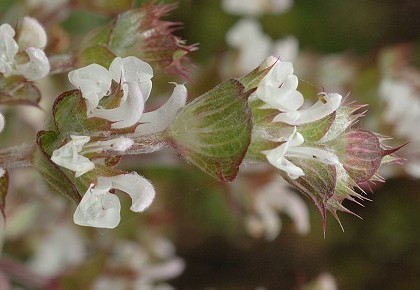Mediterranean sage
(Salvia aethiopis)

Description
Salvia aethiopis is a species of perennial plant known by the common names Mediterranean sage or African sage. It is best known as a noxious weed, particularly in the western United States. It is native to Eurasia and was probably introduced to North America as a contaminant of alfalfa seed. It is a weed of rangelands and pastures. It is unpalatable to livestock, it disrupts native floral communities, and it becomes a physical nuisance due to the similarity of the persistent dried stems to tumbleweed. The weevil Phrydiuchus tau is used as an agent of biological pest control on this plant. Boya and Valderde examined a sample of Salvia aethiopis. Acetone extracts of the root furnished a new orthoquinone diterpene, aethiopinone (4,5-seco-5,10-friedo-abieta-4(18),5,6,8,13-pentaen-l1,12-dione). This compound was isolated in 0.15% yield from the dry roots. Salvia is the largest genus of plants in the sage family Lamiaceae, with nearly 1000 species of shrubs, herbaceous perennials, and annuals. Within the Lamiaceae, Salvia is part of the tribe Mentheae within the subfamily Nepetoideae. One of several genera commonly referred to as sage, it includes two widely used herbs, Salvia officinalis (common sage, or just "sage") and Salvia rosmarinus (rosemary, formerly Rosmarinus officinalis). The genus is distributed throughout the Old World and the Americas (over 900 total species), with three distinct regions of diversity: Central America and South America (approximately 600 species); Central Asia and the Mediterranean (250 species); Eastern Asia (90 species). Salvia species include annual, biennial, or perennial herbaceous plants, along with woody subshrubs. The stems are typically angled like other members in Lamiaceae. The leaves are typically entire, but sometimes toothed or pinnately divided. The flowering stems bear small bracts, dissimilar to the basal leaves—in some species the bracts are ornamental and showy. The flowers are produced in racemes or panicles, and generally produce a showy display with flower colors ranging from blue to red, with white and yellow less common. The calyx is normally tubular or bell shaped, without bearded throats, and divided into two parts or lips, the upper lip entire or three-toothed, the lower two-cleft. The corollas are often claw shaped and are two-lipped. The upper lip is usually entire or three-toothed.
Taxonomic tree:







